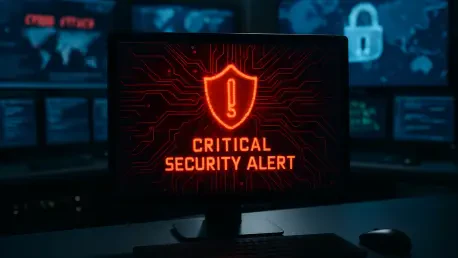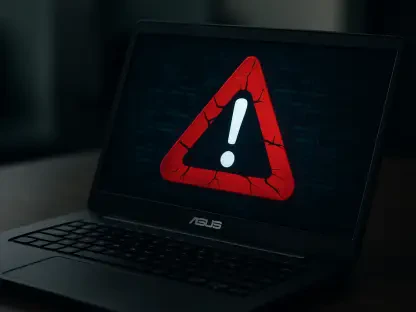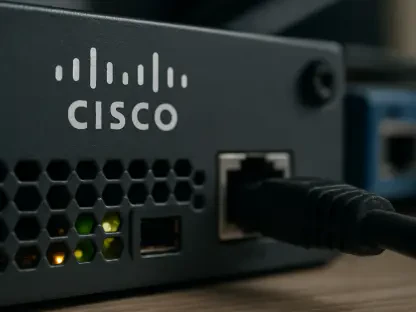What happens when a guardian of digital safety becomes the target of a ruthless attack? Picture a fortress, built to protect countless organizations, suddenly revealing a hidden crack that invaders are already exploiting. This is the reality for Fortinet, a leading name in network security, now battling a severe vulnerability in its FortiWeb Fabric Connector. Identified as CVE-2025-25257, this flaw allows attackers to manipulate databases with unauthorized SQL commands through simple web requests. The stakes couldn’t be higher as cybercriminals move at lightning speed to breach systems worldwide.
The Urgency of Fortinet’s Flaw: Why It Matters
This isn’t just a technical hiccup—it’s a glaring warning for every business relying on Fortinet’s tools. The FortiWeb Fabric Connector, a key component for integrating various Fortinet products, is central to features like single sign-on and dynamic policy enforcement. When such a critical piece of infrastructure is compromised, entire networks are at risk of cascading failures. With exploitation actively underway since early July, as reported by cybersecurity watchdogs, the incident underscores a harsh truth: no system is invincible, not even those designed to protect.
The broader implications are staggering. In a hyper-connected world, where data breaches can cost millions and erode trust overnight, this vulnerability serves as a wake-up call. Organizations must recognize that even trusted solutions can become liabilities if not vigilantly monitored and updated. The rapid pace of attacks, shrinking the window for response, amplifies the need for immediate action to prevent devastating outcomes.
Unpacking the Threat: How the Vulnerability Works
At the heart of this crisis lies CVE-2025-25257, an unauthenticated SQL injection flaw. This means attackers don’t need login credentials to wreak havoc—they can simply craft malicious HTTP or HTTPS requests to manipulate databases directly. Such ease of access makes this vulnerability particularly dangerous, turning a routine interaction into a gateway for chaos. The potential for data theft, system disruption, or even ransomware deployment looms large over affected users.
Data from the Shadowserver Foundation paints a grim picture: at its peak, 85 FortiWeb instances were compromised on a single day, with numbers dropping to 49 by the end of the week. While this decline suggests some organizations have taken defensive measures, persistent exploitation indicates the threat is far from contained. The speed of these attacks, emerging almost immediately after the flaw’s discovery, reflects a troubling trend of ever-faster cyber offensives.
Moreover, the anonymity of the threat actors adds another layer of concern. Without knowing whether their motives are financial gain, espionage, or sheer disruption, companies must prepare for a range of worst-case scenarios. This uncertainty, combined with the connector’s pivotal role in Fortinet’s ecosystem, creates a volatile situation demanding urgent resolution.
Voices of Alarm: Experts Weigh In on the Crisis
The cybersecurity community has sounded a unified alarm over this escalating danger. Ryan Dewhurst from watchTowr cautions, “Threat actors are outpacing response times—exploits are active within days of a flaw’s exposure, leaving no margin for delay.” This sentiment is reinforced by Patrick Garrity of VulnCheck, who states, “The severity here is undeniable; this is a direct route to total system compromise.” Their warnings highlight the shrinking timeline organizations face in addressing such risks.
Official bodies are equally concerned. The Cybersecurity and Infrastructure Security Agency (CISA) has added this vulnerability to its catalog of known exploited flaws, signaling its critical status to every IT department. Fortinet itself has confirmed active exploitation through updated security guidance, aligning with initial findings by GMO Cybersecurity. These combined voices, backed by real-time data on compromised systems, emphasize that hesitation is not an option in the face of such a pervasive threat.
The Real-World Impact: Businesses on the Brink
Consider the case of a mid-sized financial firm relying on Fortinet’s solutions for secure transactions. If attackers exploit this flaw, they could access sensitive client data, disrupt operations, or hold systems hostage for ransom. Such scenarios are no longer hypothetical—active exploits since July 11 demonstrate that real damage is already occurring across various sectors. The ripple effects could undermine customer confidence and lead to regulatory penalties, compounding financial losses.
Beyond individual companies, entire industries face heightened risks. Healthcare providers, government agencies, and retail giants—all frequent users of Fortinet’s tools—must grapple with the possibility of breaches exposing personal information or critical infrastructure. This widespread vulnerability illustrates how a single flaw can threaten the digital backbone of modern society, pushing cybersecurity to the forefront of strategic priorities.
Defending Against Disaster: Steps to Secure Systems
For organizations using FortiWeb Fabric Connector, swift action is non-negotiable. Begin by consulting Fortinet’s latest advisory to identify and apply patches specifically targeting CVE-2025-25257. These updates are the first line of defense in sealing the breach. If immediate patching isn’t possible, disabling the affected administrative interface can serve as a temporary shield against unauthorized access.
Continuous monitoring is equally vital. With exploitation ongoing for weeks, network logs must be scrutinized for any signs of abnormal activity. Leveraging resources from CISA on known vulnerabilities can provide additional guidance for broader security enhancements. Finally, establishing a rapid-response framework ensures that future alerts—whether from Fortinet or independent researchers—are addressed without delay. These practical measures offer a lifeline amid an active and evolving threat.
Looking back, the Fortinet vulnerability crisis served as a stark reminder of the relentless pace of cyber threats. It exposed how even trusted protectors of digital spaces could falter under targeted attacks. Yet, it also galvanized a collective push for stronger defenses. Moving forward, organizations had to prioritize proactive patching, real-time monitoring, and cross-industry collaboration to stay ahead of adversaries. The lesson was clear: in cybersecurity, complacency was the greatest risk, and readiness became the ultimate safeguard.









